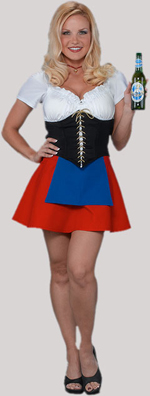|
|||||
|
Mr. Oktoberfritz |
|
BARNTOBERFEST! Saturday, September 30, 2006!
The Barn and Friends are proud to announce our summer (well, actually the first weekend of fall) party!!!
We are going all out once again... Far out... International...
Presenting...BARNTOBERFEST! Saturday, September 30, 2006!
No reason to fly to Germany for Oktoberfest this year! With the help of some experienced "consultants", the Barn is bringing Bavaria to the Jersey shore!
Here's your chance to wear the Lederhosen and Dirndl you have in the closet! And break out that beer stein on your mantle collecting dust!
Join us for the celebration of Bavaria's favorite beverage in our giant beer tents. And feast on our buffet of Bavarian food!
Dancing to Polka and other authentic music. Maybe even live performances!
Not to mention the following tests of skill and stamina:
Yodeling Contest!
Bratwurst Eating Contest! (Style not quantity
 )
)Arm Wrestling Contest!
Best Costume (Men's and Woman's) Contest!
Tastiest Home Brewed Beers!
And most importantly - Beer Chugging!
As always, bring a bottle of your favorite German liquor for our ice slab! And a German dish to add to our authentic buffet.
Festivities will begin at 3 PM. The Barn will be asking a $10 donation at the door to help cover our expenses which are sure to be many!
The Barn welcomes everyone to sleep over after the party. No need to drive home! For those who prefer privacy, bring a tent to pitch on the lawn or reserve a room at the nearby Bed and Breakfast. Rates are reduced for fall.
If the weather is nice, we'll spend Sunday at the beach.
Stay tuned for more info. Much more to come! We are giving you months of notice - so please mark your calendars and join us! Get your plane tickets now out-of-towners!
"Ozapft is!"
Chris, Mark, Toka, Andy and Friends
P.S. - Yes, Octoberfest really does begin in September. For real!
The History of Oktoberfest
The first Oktoberfest started on October 12, 1810. It was given by Bavarian King Maximillian Joseph to celebrate the marriage of his son, the Bavarian Crown Prince Ludwig to Princess Therese von Sachsen-Hildburghausen. The festivities ended on October 17th with a horse race. The following year the festival became an annual event in order to celebrate this wedding for all time.
At the time of the first festival, horse racing was beginning to die out in popularity, but Franz Baumgartner, corporal of the national guard, presented the idea of horse racing to the king, and the king loved the idea, so five days after the wedding, horse races were held on the meadow in front of the Sendlinger Tor, which is one of Munich's many gates. The Guard cavalry requested that the the grounds on which the races took place be named "Theresienwiese" in honor of the crown princess. To this day, Oktoberfest still takes place on the Theresienwiese, or what locals of Munich like to refer to as "die Wiesn" (the meadow) for short. Wiesn is now just another word for Oktoberfest. In 1811 an agricultural fair was added to the races and by 1818 the first carousel and two swings were added for amusement, as well as some small beer stands which grew rapidly in number. In 1896 the beer stands were replaced by the first beer tents. The horse races were removed in 1938, but the rest of the traditions still survive to this day.
At exactly 11 a.m. the Oktoberfest opening day ceremonies begin with the Oktoberfest Costume and Riflemen's Parade. This parade involves about 1,000 participants, including the landlords' families in decorated carriages, the horse-drawn drays of the Munich breweries, waitresses on decorated floats, and all the beer tent bands. The parade ends at the Schottenhamel tent at noon, which is the oldest private tent at Oktoberfest, where the lord mayor of Munich has the honor of tapping the first keg of Oktoberfest beer. A cannon is fired twelve times, and then the mayor taps the first keg and declares, "Ozapft is!", which means "The keg is tapped!" Once this barrel is tapped, all visitors are then allowed to order beer. On the second day there is a parade called the Trachtenfest, which is a celebration of traditional costumes. German men wear Lederhosen, which are leather shorts usually worn with suspenders, white shirts and knee-high stockings. German women often wear a colorful Dirndl, which is a flowery folk dress. On the second Sunday of Oktoberfest all of the bands performing during the sixteen days perform at a one-hour concert at the main entrance to the festivities.
Now you might be wondering, if these festivities started in October, and is called Oktoberfest, then why do they now start in September? The answer is that the festivities have been made longer, and by moving it into September, visitors can enjoy the outside gardens and tents longer because the weather conditions are much warmer in September than in October. Now the Oktoberfest is sixteen days of events and always starts on a Saturday in September and ends on the first Sunday in October.
St. Pauli Girl 2006 Brittany Evans |
 |